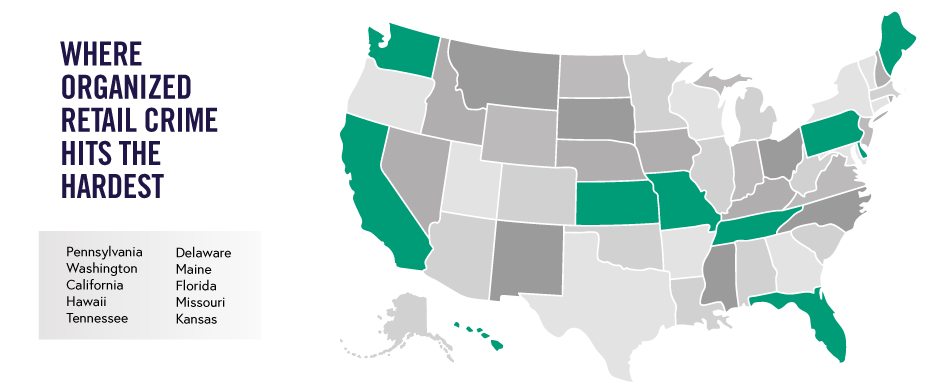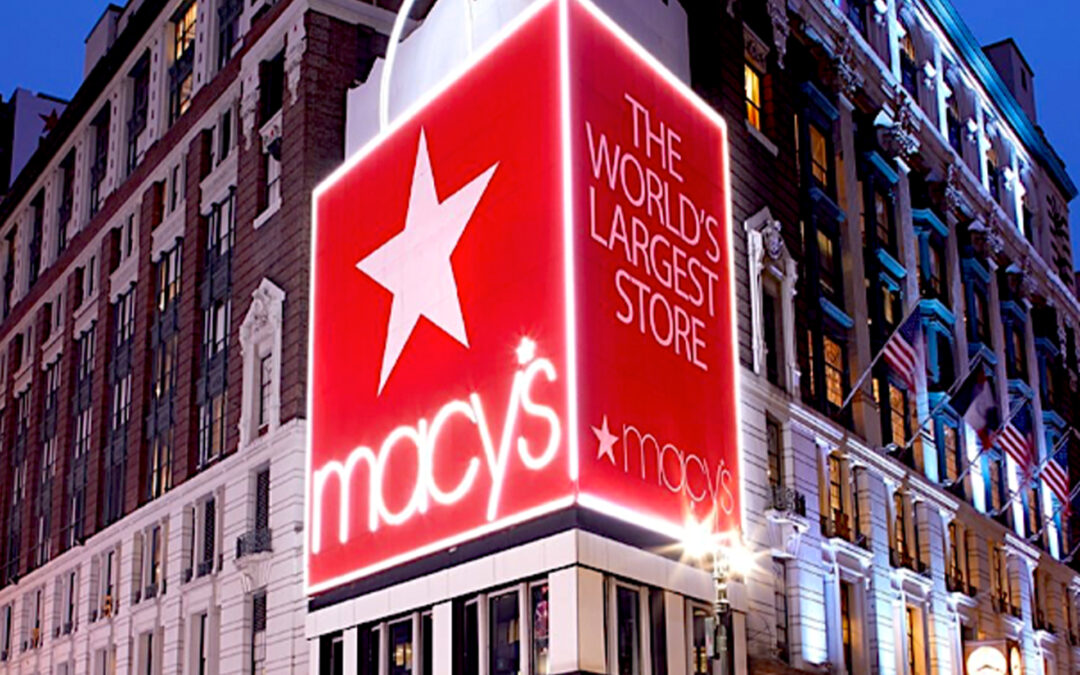The Integrity, Notification, and Fairness in Online Retail Marketplaces for Consumers Act, or INFORM Act, has been signed into law and will take effect in June. The INFORM Act, along with two additional bills, one each in the United States Senate and House of Representatives, are helping advance the fight against organized retail crime (ORC), but they are only a beginning.
The retail industry and its supporters among its supplier base have a vested interest in not only seeing all the legislation implemented but also in following up by pressing for its practical implementation in an era when retail crime has become a significant problem. This is the case not only for store operators but also for communities where theft is causing retailers to change policies and even leave communities because of losses and the threat of violence against employees and customers.
It doesn’t end there. Crime prevention professionals and those who work with them in combating ORC make the point that too many people and officials still think of the theft of store merchandise as a small-time crime. Many fail to recognize it is big business for criminals who understand it to be low risk, profitable and a source of capital needed to fund even larger and more lucrative illicit activities, including drug and human trafficking.
Indeed, movement on legislation and in communities where officials have taken a second look at ORC and its consequences comes in large part from recognition that the problem isn’t about someone stealing a shirt: It’s potentially about giving criminals a big infusion of cash that can come back and haunt a locality.
In December of last year, with the support of retailers, suppliers and trade organizations, including the International Housewares Association, the INFORM Act became law. Getting it passed is only a step in the ongoing drive to thwart organized retail crime.
New bills in the United States Senate and House or Representatives are looking to take the fight against ORC even further.

Photo: Buy Safe America
A year earlier, in December 2021, 20 CEOs of leading retailers expressed support for the INFORM Act in a letter to Congress touting it as a measure to quell the growing impact of organized retail crime on retail employees and the communities they serve by making it harder for bad actors to sell stolen products online. Signatories included Corie Barry of Best Buy, who was an early voice among CEOs in speaking out publicly about the need to combat organized retail crime, as well as Rodney McMullen, of The Kroger Co.; Richard Keyes of Meijer; Erik Nordstrom of Nordstrom; Heyward Donigan of Rite Aid Corp.; Brian Cornell of Target Corp.; Neela Montgomery of CVS Health; Todd Vasos of Dollar General Corp.; Craig Menear of Home Depot; Geoffroy van Raemdonck of Neiman Marcus; Anthony Hucker of Southeastern Grocers; David Kimbell of Ulta Beauty; and John Standley of Walgreens Boots Alliance. The hope of the signatories is that cutting off an easy way to sell stolen merchandise in volume would make everything from individual shoplifting to raids by multiple criminals less lucrative and attractive.
Walgreens has been a high-profile ORC victim in that such crime, costs associated with it and fear for the safety of employees and customers became a key reason behind a decision to close several stores in San Francisco.
In 2021, Fraser Engerman, senior director, external relations at Walgreens, said actions taken internally by retail loss prevention specialists and recognition of the problem by prosecutors, including in its home state of Illinois, where the attorney general backed an organized retail crime task force, were steps in the right direction. In the months after, some of the momentum has been taken out of ORC’s growth across the U.S., but the problem remains.
After it was voted into law, Engerman told HomePage News Walgreens continues to wrestle with ORC and the trouble it can cause.
“Although we are pleased to see retail shrink levels stabilize, this is still a serious national problem affecting all retailers,” Engerman said. “We have taken a number of steps to address this issue and, most importantly, protect the safety of our customers and team members, including our highly valued partnerships with law enforcement and security professionals.”
The problem remains a challenge faced by all retailers. The fact that major retailers have needed to address organized retail crime in their public statements suggests how much it is weighing on sector executives. Despite hundreds of billions of dollars in sales, Walmart felt compelled to address ORC. In late 2022, Doug McMillon, CEO of Walmart, said in a CNBC interview that increases in organized retail crime had brought it to historically high levels. He made the point that more criminal activity-created costs would be passed on to the consumer and could lead to store closings.
As for what McMillon would like to see government provide, he commented, “policy consistency and clarity so we could make capital investments with some vision.”
Although we are pleased to see retail shrink levels stabilize, this is still a serious national problem affecting all retailers. We have taken a number of steps to address this issue and, most importantly, protect the safety of our customers and team members, including our highly valued partnerships with law enforcement and security professionals.
– Fraser Engerman, Senior Director, External Relations, Walgreens
Just about any retailer can be an organized retail crime victim. Those who carry over-the-counter drugs and tools tend to have it particularly bad as they are stocked up on expensive portable products in demand and readily resold. The ability to sell online has made the problem worse and more lucrative for criminals particularly where laws and rules regarding what constitutes a felony and what violations require bail for release have loosened. In places where the government had raised felony thresholds, 70.8% had reported a moderate (36.6%) or substantial (34.2%) increase in ORC incidents, according to the 2022 National Retail Security Survey. Moreover, 54.6% of retailers reported a substantial increase in repeat offending in places where cash bail was reduced or eliminated, while 15.2% reported a moderate increase. In those circumstances, thieves, either single shoplifters or groups who raid stores, could be fairly assured that if they are caught, the penalty would be acceptable. The store-level thieves or boosters can tap into systems that allow quick turnover of goods to cash. Given that a steady stream of products is available, organized fences emerge with the technical dexterity to quickly sell goods online to unknowing consumers online, to cooperative bricks-and-mortar stores and to wholesalers and distributors who commingle legitimate and illicit goods and sell them to unwary retailers.
Coresight Research, in its report on organized retail theft, concurred with the view that it is a multifaceted problem that won’t be solved by any simple measure. Indeed, even as more concern and action take place regarding the problem, it hasn’t gotten any better and in some ways, it has worsened, as numbers on what happens after felony thresholds rise suggests — even if it has recently stabilized to some degree in terms of losses, as Engerman suggested.
ORC increased 59% from 2015 to 2020, totaling $719,548 for every $1 billion in U.S. retail sales, Coresight observed. As such, retailers have to pursue a multi-part approach, including investing in their own security operations and working with organizations including trade associations to share information and best practices, with all interested parting teaming up to educate policymakers.
In the 2022 Retail Security Study, and similar to the five years before, the average shrink rate among U.S. retailers in 2021 was 1.4%. When that proportion is applied to 2021 total retail sales, shrink losses totaled $94.5 billion, up from $90.8 billion in 2020. Retail shrink has multiple causes, but the National Retail Federation stated such shrink is driven primarily by external theft, including that caused by ORC. The NRF attributed 37% of the shrink to external theft, 28.5% to employee/internal theft, $25.7 to process/control failures, 1.2% to other sources and 7.7% to unknown causes. Retailers, on average, saw a 26.5% increase in ORC incidents in 2021 as criminal activity grew with sales.
More alarming than the dollars lost is that eight in 10 retailers surveyed reported aggression and outright violence associated with ORC incidents increased during the year. In the study, 77.6% of respondents said that guest-on-associate violence had increased, with 44% saying somewhat more and 32.8% saying much more. At the same time, 74.1% of respondents said external theft, including ORC, had increased— 39.7% indicating somewhat, and 34.5% reporting much more. On top of that, 70.7% of respondents said organized retail crime had risen specifically, with 38% saying somewhat and 32.8% saying much more. Cybercrime, mass violence/active assailants, internal theft, gun violence and gift card fraud all gained 50% or more. Over the year prior to the 2022 study publication, retailers reported an increase in aggression, with 35.9% saying much more and 45.3% saying somewhat more. Less than 6% of retailers said aggression and violence were somewhat or much less.
The risks involved in confronting shoplifters are such that 37.9% of retailers don’t allow any personnel to apprehend thieves, and 56.9% only allow AP/LP personnel.
That being said, as NRF reported, the multifaceted nature of theft in the retail sector is on the rise, with in-store, e-commerce and omnichannel crime all gaining. As bad as the particulars of the criminal activity have been, the ancillary effects are broadly troublesome. The combination of labor shortages and concern among potential employees about violence, including the kind of gun violence that has made news in recent months, makes staffing tougher.
Retailers are putting more resources behind deterring crime against them. In the NRF study, 52.4% of retailers said they are increasing budgets for capital and equipment to combat criminals from artificial intelligence-based video surveillance to self-service locking cases and even autonomous security robots. Technology is an important tool for retailers to tap into. In the NRF study, RFID systems for use in identifying and recovering stolen goods were the preferred technology for more retailers than any other at 38.6. Next, at 29,8%, was AI-based point-of-sale and self-service checkout video analytics to detect criminals trying to avoid paying for or paying full price for merchandise. That was followed by license plate recognition equipment to identify and/or trace bad actors, at 19.3%; and self-service locking cases or lockers, at 17.5%.
As NRF reported, the multifaceted nature of theft in the retail sector is on the rise, with in-store, e-commerce and omnichannel crime all gaining. As bad as the particulars of the criminal activity have been, the ancillary effects are broadly troublesome. The combination of labor shortages and concern among potential employees about violence, including the kind of gun violence that has made news in recent months, makes staffing tougher.
The resource commitment already is significant and often beyond capital investment, the median retail LP/AP department size was 32, while the average was 391.4. The average number was pushed higher by retailers that have sales between $10 billion and $24.9 billion, which have an average team size of 735.5 and a median of 715; and those at $25 billion or more with an average team size of 2,041.1 and a median of 900.
The teams are needed because retailers often have to self-investigate retail crime, particularly organized retail crime, given the limited resources of local law enforcement and prosecutors’ offices. The recent reductions in grade and penalties associated with crime also make individual incidents less of a priority for law enforcement, which recognizes that, in some cases, the statutes now governing shoplifting and related criminal activity create little in the way of penalties, which, in effect, can make enforcement questionable. However, if retailers can make a case for organized retail crime, law enforcement and prosecutors have more motivation to act.
Still, retail loss prevention and security measures are expensive, and only 31.5% of respondents to the NRF survey had an ORC team.
Many retailers have reached the point where they have put policy changes in place to help them deal more effectively with ORC and related criminal activity. In the NRF study, few had or planned to change their policies in the 2021/2022 time frame except when it comes to e-commerce. Even as part of digital operations, only 19.2% of retailers said they had changed policies in 2021, and only 6.4% said they would do so in 2022.
Retailers can have only so much impact on ORC individually. A broad consensus has emerged, often articulated by trade organizations, on the need for additional ORC law enforcement measures. When asked about whether Federal ORC legislation is needed, 86.8% of survey respondents said yes.
INFORM Action
Passage of the INFORM Act by Congress was an important advance in the fight against ORC.
At its passage, NRF, as one of the organizations supporting the law, noted that the act would bring needed transparency to online selling activities. Under INFORM, marketplaces must verify the identities of high-volume, defined as making more than 200 transactions and grossing more than $5,000 a year, third-party sellers. The law makes it more difficult for fences to push illegal goods into the marketplace via the Internet.
“While ORC can vary in scope and scale, the common denominator is that the activity is a coordinated, organized effort,” said David French, NRF senior vice president, government relations. “These criminal rings operate sophisticated enterprises that aim to ransack retailers and sell illegally obtained merchandise for profit, endangering both employees and consumers.”
The act focuses not on online sellers per se but requires those high-volume online sellers, including those that have the typical profile of an ORC fence, to provide identification, which can deter criminal activity or provide law enforcement information they can use against bad actors.
“The act applies to online marketplaces and requires them to collect information from ‘high-volume third-party sellers,’” said Betsy Laird, senior vice president, global public policy, office of global public policy at the International Council of Shopping Centers (ICSC). “The platforms are required to make that information available to potential customers of the online sites. It gives the Federal Trade Commission enforcement powers and allows state attorneys general to bring civil actions against online marketplaces whose noncompliance with the act affects residents of their states. All of this will provide the opportunity to prevent the underlying activity of theft and/or the manufacturing of knockoff goods that has a detrimental impact on retailers.”
Another major backer of the INFORM legislation, the Retail Industry Leaders Association, has emphasized the need to shine a brighter light on a marketplace trade channel that provided a degree of anonymity sufficient to make it relatively easy for fences to sell illegal merchandise.
Jason Brewer, RILA senior executive vice president, communications and marketing, said. “The law goes into effect at the end of June. Once that happens, the FTC and each state attorney general will have authority to enforce the provisions in INFORM.”

Betsy Laird, SVP, Global Public Policy, Office of Global Public Policy at the International Council of Shopping Centers
The act applies to online marketplaces and requires them to collect information from ‘high-volume third-party sellers. The platforms are required to make that information available to potential customers of the online sites. It gives the Federal Trade Commission enforcement powers and allows state attorneys general to bring civil actions against online marketplaces whose noncompliance with the act affects residents of their states. All of this will provide the opportunity to prevent the underlying activity of theft and/or the manufacturing of knockoff goods that has a detrimental impact on retailers.
– Betsy Laird, SVP, Global Public Policy, Office of Global Public Policy, ICSC
In part, the passage of the INFORM Act was predicated on getting legislators to recognize the scope of the problem and how it fits into a bigger criminal context.
“The problem has certainly gotten worse in recent years, with in-store violence a key concern for retailers,” Brewer said. “ The financial losses associated with habitual theft and organized retail crime are significant, but they don’t compare to an associate being harmed or killed. This is also a community safety issue because the criminal syndicates building a business model selling stolen goods are often involved in gun trafficking, narcotics sales, human trafficking and other crimes in the community.”
Retailers have been doing a significant part in combating organized retail crime as their loss prevention teams work closely with law enforcement and prosecutors who have become more aware of the ORC problem scope.
“We are also pleased with the recent passage of the INFORM Consumers Act,” Walgreens’ Engerman said, “which will help to remove the anonymity on online platforms by creating basic accountability measures that protect consumers from illicit goods. This legislation will aid law enforcement in their efforts to track organized crime, making it more difficult for bad actors to build illegal businesses and profit by selling stolen or counterfeit merchandise.”
Still, the INFORM Act only addresses one element in a larger criminal undertaking and, as with counterfeit goods, a problem that has similar dynamics and overlaps in its manifestation with that of stolen merchandise, criminals will do what they can to keep their endeavors going.
“This is a problem that has been building for some time, and will require long-term thinking to solve,” RILA’s Brewer said. “Beyond making it harder to sell stolen goods, we obviously need partnerships at the local level to address the nexus of retail crime and the societal challenges of addiction and mental health. Those aren’t easy problems to solve either, but there is an obvious correlation between many of the challenges facing society and the impact they have on local businesses. Building coalitions with other businesses like hotels and restaurants is important, as is having serious discussions about diversion and prevention programs that try to rehabilitate and provide help for those suffering from addiction or mental illness.”
Retailers are addressing the challenge of organized retail crime to the extent law and resources allow.
“Retailers are making big investments in both physical security and technology to deter and disrupt theft, and to track stolen product,” Brewer said. “Closing a store is obviously a worst-case scenario for a retailer, but obviously it has to be a consideration if a store is unable to protect its employees or keep product on shelves.”
INFORM creates more transparency online, which will make it harder to anonymously sell stolen goods. It’s an important step, but it isn’t going to solve the ORC problem on its own. Addressing organized retail crime and habitual theft will require an ongoing effort, including partnerships with law enforcement, social service organizations and other stakeholders. But for the first time, marketplaces will have a reason to cooperate with retailers and law enforcement.
CORCA
The Combating Organized Retail Crime Act (CORCA) of 2022 takes another approach to disrupting ORC.
As introduced to the U.S. House by Representative Ken Buck (R-CO), it would establish an Organized Retail Crime Coordination Center in the Department of Homeland Security. The central element of the legislation is the establishment of an ORC center that would coordinate federal law enforcement activities involving retail crime including investigation of national and transnational criminal organizations engaged in those activities. The center would establish relationships with state and local law enforcement and share ORC-related information. It would assist state and local authorities in investigating organized retail crime groups and establish relationships with retail companies to create a dialogue about ORC activity and threats. The center also would be charged with tracking trends in and around the issue and produce an annual report on organized retail crime. Co-sponsors in the House are Rep. Dina Titus (D-NV), Rep. Susie Lee, (D-NV), and Rep. David Joyce (R-OH). An original co-sponsor, Representative Ted Budd from North Carolina, is now a Republican senator from the state.
On the other side of the capitol, a bill sponsored by Senator Chuck Grassley, (R-IA) and co-sponsored by Senator Catherine Cortez Masto (D-NV) and Senator John Kennedy (R-LA) established an ORC center on similar lines to the House bill.

Senator Chuck Grassley
Stores throughout American communities have not been spared from a national crime wave. These organized theft rings have been developing new tactics to pilfer goods, causing economic harm to American businesses and putting consumers at risk while funding transnational criminal organizations throughout the world. These criminals are exploiting the Internet and online marketplaces to stay one step ahead of the law, and it’s time the law catches up. This bill improves our Federal response to organized retail crime and establishes new tools to recover goods and illicit proceeds and deter future attacks on American retailers.
– Senator Chuck Grassley
Although a Justice Department center on organized retail once existed for a short period, no ongoing federal organization has existed to combat ORC. Even as it emerged as a growing concern through the pandemic and its aftermath, federal agencies couldn’t consistently deal with organized retail crime amid their many statutory commitments. Once legislated — and the legislation includes specific staffing and reporting requirements to ensure its mission would be carried out —the new center would be a constant resources state and local governments, as well as retailers, could tap into to further their own efforts to thwart criminals, which is especially important because ORC supersedes even international boundaries.
Senator Grassley told HomePage News, “Stores throughout American communities have not been spared from a national crime wave. These organized theft rings have been developing new tactics to pilfer goods, causing economic harm to American businesses and putting consumers at risk while funding transnational criminal organizations throughout the world. These criminals are exploiting the Internet and online marketplaces to stay one step ahead of the law, and it’s time the law catches up. This bill improves our Federal response to organized retail crime and establishes new tools to recover goods and illicit proceeds, and deter future attacks on American retailers,”
Laird said the new legislation can help deal with organized retail crime as it exists and evolves.
“ORC is a multifaceted problem that demands a myriad of solutions,” she says. “Unlike so many issues, there is no singular fix. The latest bills in Congress are about toughening enforcement and centralizing the sharing of information about ORC activity. The legislation establishes a coordinated multi-agency response and creates new tools to tackle evolving trends in organized retail theft.”
In addition to the coordination aspect, the Combating Organized Retail Crime Act establishes other means to combat ORC.
Laird noted that it “allows for Federal judges to order criminal forfeiture after convictions of organized retail theft-related crimes.”
She added that it strengthens Federal money laundering statutes so investigators and prosecutors can target the illegal proceeds of organized retail crime groups. Further, the new legislation ensures that ORC crime group members who use the Internet or other forms of interstate or foreign commerce in their illicit activities are investigated and prosecuted. And it allows for Federal prosecutors to use the aggregate total value of $5,000 or more over a 12-month period as a predicate for charging the transportation, sale or receipt of stolen goods.
Still, Laird of the International Council of Shopping Centers said retailers and those businesses and organizations affiliated with them “have a stake in dealing with ORC as it impacts their businesses, their customers, employees and the communities where we all work and live.”
In addition to its own members, Laird said ICSC continues working with major associations representing retailers, other stakeholders and business organizations to promote federal legislation and state-level initiatives to address ORC activity in its various forms and to mitigate its several effects on retailing and beyond.
The National Retail Federation has made a point of disseminating the key features of the CORCA legislation. Here is a summary of what CORCA legislation entails:
- Establishes a federal Organized Retail Crime Coordination Center located within Homeland Security Investigations at the Department of Homeland Security and staffed by other key federal law enforcement partners. State, local and tribal law enforcement agencies could detail officers to the center, and they and the private sector would have formal roles as advisors to the center.
- Gives the center clear responsibilities to coordinate counter-ORC activities nationally and internationally, including the development of a national-level ORC intelligence perspective, coordinating information-sharing and cross-agency investigations, and serving as a center of expertise for training and technical assistance.
- Establishes regional federal, state, local and tribal law enforcement task forces at multiple HSI field offices as a pilot project then considering whether to expand more broadly.
- Requires the Department of Homeland Security and the Department of Justice to leverage and expand the focus of existing law enforcement grant, training and technical assistance programs so that they more actively prioritize ORC.
- Allows federal judges to order criminal forfeiture after convictions of organized retail theft-related crimes.
- Strengthens federal money laundering statutes allowing investigators and prosecutors to target the illegal proceeds of organized retail crime groups.
- Ensures that members of organized retail crime groups who use the Internet or other forms of interstate or foreign commerce in furtherance of their illicit activities are investigated and prosecuted.
- Allows federal prosecutors to use an aggregate total value of $5,000 or more over a 12-month period as a predicate for charging the transportation or sale or receipt of stolen goods.
“ORC is a growing problem that state and local lawmakers, our industry, and the public all agree upon,” Laird said. “The costs to states and local governments are innumerable in terms of economic loss, lost wages and lost jobs. Both state and federal law enforcement agencies play a critical role in dismantling these criminal organizations. Ongoing outreach and education by impacted retailers to state and local lawmakers is paramount.”
Tony Sheppard, senior director, loss prevention solutions, at ThinkLP, noted, for all the potential good they can do, neither the INFORM Act or CORCA have automatic enforcement mechanisms attached. They create conditions that can help identify bad actors, but others have to play a role in enforcement. With the INFORM Act, marketplace operators are required to establish the identity of their sellers and deny access to those who won’t comply. However, as anyone who has dealt with online counterfeiting can ascribe, criminals will do whatever they can to remain on platforms that allow them to make money. In the simplest case, online fences can use multiple accounts to stay under the volume the INFORM Act reporting requirement.
Sheppard said criminals will get creative in trying to dodge the INFORM Act, and marketplace operators are only going to devote so many resources to enforcement. So, vigilance is key. Retailers have to stay on top of the issue as it affects their stores and brings information about illicit activities to the relevant authorities. As such, loss prevention and security personnel who follow ORC crime can monitor and report on activities, something many already are doing, to bring evidence to marketplace operators, law enforcement and the FTC to address bad actors.
“When it comes to how effective that will be, a lot of that will fall back on the retailers,” Sheppard said.

Tony Sheppard, Senior Director, Loss Prevention Solutions, ThinkLP
Sheppard said criminals will get creative in trying to dodge the INFORM Act, and marketplace operators are only going to devote so many resources to enforcement. So, vigilance is key. Retailers have to stay on top of the issue as it affects their stores and brings information about illicit activities to the relevant authorities. As such, loss prevention and security personnel who follow ORC crime can monitor and report on activities, something many already are doing, to bring evidence to marketplace operators, law enforcement and the FTC to address bad actors.
Sheppard said dedication is required, because, unlike the case with counterfeit goods that are often lower quality than expected or even defective, the marketplace operators are unlikely to get many customer complaints about authentic merchandise that was stolen. If an online marketplace isn’t getting customer complaints, they have less motivation to act. That means retailers seeking compliance will have to bring cases to their attention or, if compliance is lacking or lackadaisical, to state attorneys general in those geographies where they are headquartered and the FTC. As marketplaces pop up all over the Internet, the challenge to suppress online fencing of stolen goods is significant.
Similarly, CORCA legislation effectively creates an agency to monitor and a resource that can help law enforcement but not the direct means to go out and arrest ORC operators. Coordination with state and local law enforcement is the crux of the matter. Annual reports that identify problems and bring them out into the open can be a further catalyst for change, but it will be retailers working with law enforcement and the FTC that will compel that change.
Even if they aren’t perfect solutions, Sheppard said, The INFORM Act and CORCA will have distinct advantages and give law enforcement new tools. Retailers will continue to have a major role in tracking and identifying fences who find ways to thwart the immediate provisions of the laws. However, having more and greater communications can be a first step toward better solutions as in the case of a fence selling goods across state lines, which brings in a whole different enforcement equation and, potentially, more severe penalties.
Jonathan Gold, NRF vice president, supply chain and customs policy, says the INFORM Act and CORCA legislation is something the organization has pushed and represents another stride forward.
“This is the first part of the battle,” Gold said. “The state retail associations have been doing a great job,” he added.
To keep the anti-ORC momentum going will include retailers bringing discussions back to the broad community troubles that retail crime fuels. The problem isn’t about petty theft.: It is about criminal organizations that encourage continual robbery that makes needed business unprofitable, frightens customers and endanger employees. Retailers and their partners have to link ORC to the further illicit activity it helps to encourage, including, as noted, illegal firearms sales and human and drug trafficking.
“ORC is a gateway crime,” Gold said. “Retail has to show the entirety of the chain. We want to emphasize that ORC is funding other crime. It is not a victimless crime.”





